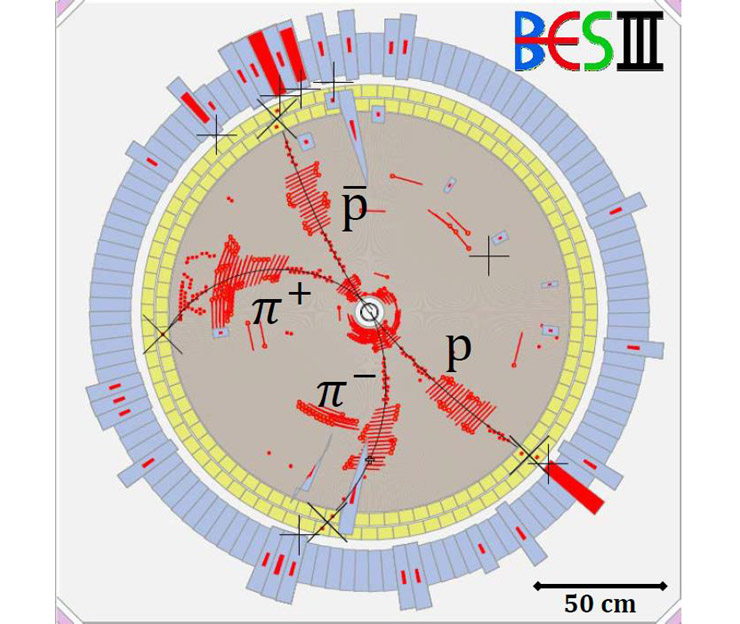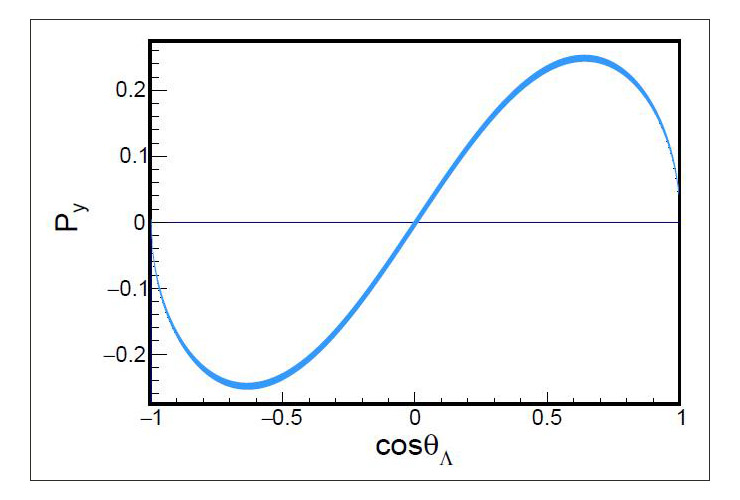BESIII Observes Polarization of Baryons in J/ψ Decay
World science, 07 May 2019
The BESIII collaboration observed baryon polarization in baryon-antibaryon (matter-antimatter particle) events from J/ψ particles produced at the BEPCII collider. The paper was published in Nature Physics on May 6.
The reaction e+e– → J/ψ → ΛΛ is illustrated in Fig. 1. The baryons used in the study are Λ hyperons. Their weak decay into proton and negative pion, Λ → pπ–, makes it possible to determine the hyperon polarization, providing a convenient hyperon polarimeter. An example of the e+e– → J/ψ → ΛΛ event with the subsequent decays Λ → pπ– and Λ → pπ+ observed in the BESIII detector is shown in Fig. 2. With BESIII data from 2009 and 2012 (corresponding to 1.3 billion J⁄ψ events), the number of such reconstructed events is 420K.
The Λ hyperons in the reaction were polarized in the y direction (defined in Fig. 1) and BESIII has determined the precise value of the polarization, which depends on the production angle θΛ as shown in Fig. 3, with the maximum reaching 25%. The observed polarization makes it possible to determine new values for the parameters of hyperon decays. The BESIII result corrects by 17% the value used in many experiments for decades. This calls for reinterpretation of all Λ hyperon polarization results.
Finally, BESIII made a direct comparison of the decay parameters of the Λ hyperon to those of its antiparticle – Λ antihyperon. This is the most sensitive test of matter-antimatter symmetry (CP symmetry) involving Lambda particles. This offers prospects for the further search for new sources of CP symmetry violation in baryon decay, using the large J/ψ data sample accumulated at BESIII and possibly even larger data samples at future experiments.
The BESIII experiment at the Beijing Electron Positron Collider is composed of about 500 physicists from 67 institutions from 14 countries. The JINR group has been participating in the experiment since 2006. The BESIII experiment contributes to China’s world-leading role in τ-charm physics. To date, the collaboration has published more than 250 papers.
 Fig. 1 Graphical illustration of the e+e– → J/ψ → ΛΛ̅ reaction (Image by BESIII Collaboration)
Fig. 1 Graphical illustration of the e+e– → J/ψ → ΛΛ̅ reaction (Image by BESIII Collaboration)
 Fig. 2. An e+e– → J/ψ → ΛΛ̅ event as seen in the BESIII detector (Image by BESIII Collaboration)
Fig. 2. An e+e– → J/ψ → ΛΛ̅ event as seen in the BESIII detector (Image by BESIII Collaboration)
 Fig. 3. Polarization of Λ particle as a function of the production angle θΛ (Image by BESIII Collaboration)
Fig. 3. Polarization of Λ particle as a function of the production angle θΛ (Image by BESIII Collaboration)